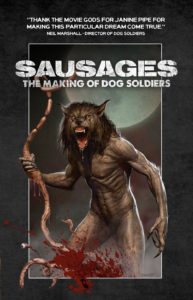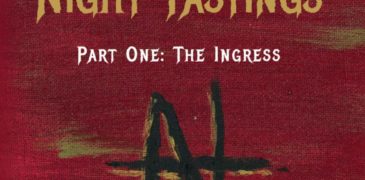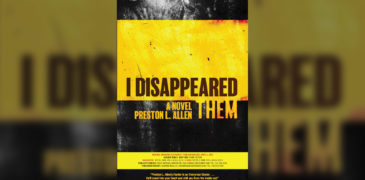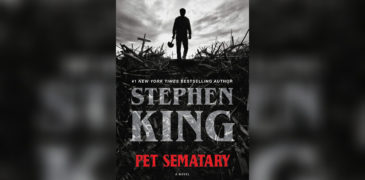
Corfu, 2002. Janine Pipe and her then-boyfriend sat in a bar whose staff had set up an illegal feed of a football match. Later, they screened an obvious pirate copy of a horror film. Despite the poor quality, Pipe was captivated. As soon as she was able, she tracked down a legitimate copy based on the two details she could recall: Sean Pertwee shoving his guts back into his stomach, and the film’s title – Dog Soldiers. Last year, in anticipation of the film’s 20th anniversary, Pipe pitched an idea to Encyclopocalypse Publications. As perhaps the film’s biggest fan, she wanted to write a book about it. She would contact the cast and crew and, hopefully, create the ultimate super-fan’s love letter. The publisher responded positively to her intense and unabashed love for the film, and the result is Sausages: The Making of Dog Soldiers.
Dog Soldiers (2002) follows a group of British squaddies on what appears to be a routine training exercise. Following a gruesome discovery, the soldiers realise that they are being hunted – not by other men, but by werewolves. Holed up in a seemingly abandoned farmhouse, they attempt to survive the night. At its core, the film is very simple. Therein lies its success. Throw a handful of talented Brits into the woods, let their chemistry naturally develop, and then add some monsters. It may be difficult to see how deeply an almost 400-page book could probe into Marshall’s feature debut. As it turns out: not deeply at all. Almost half of the book comprises a recap of the plot, replete with quoted lines, original script excerpts, and Pipe’s commentary. As the book is aimed at fans of the film (who already know the plot inside and out), the recap makes little sense, and its inclusion reads as padding on Pipe’s part. Much of her commentary offers explanations of inside jokes or film references. More still provides an outlet for her self-admitted ‘fangirling’.
Much of the book’s success or failure will hinge on the reader’s connection to Pipe’s narrative voice. She makes clear early her intention with Sausages: not to explore any negative aspects of production, but only to celebrate the film she loves more than any other. This is a book written by a super-fan, and explicitly aimed at super-fans. No attempts are made to dig deeper into possible implications or subtext. Personally, as a fan of the film, I came away from the book somewhat disappointed. There is nothing here that could not be gleaned from the DVD commentary, or behind the scenes footage (including the gag reel). In an interview with Monster Men, Pipe notes that the book offers a female fan’s perspective on a male-dominated film. However, there is little here that a male fan would not note. Pipe’s only criticism of the film is the female character’s most important line. Others have critiqued the film’s “girlboss werewolf moment” and Pipe’s analysis offers nothing new.

Sausages cover – designed by Dave Bonneywell
Dog Soldiers‘ werewolves – brought to howling life by Bob Keen, Dave Bonneywell, and the other SFX artists (interviewed herein are Mat O’Toole, Justin Pitkethly, and Anthony Parker) – remain arguably the best examples in cinema. Sadly, while Pipe expresses an unadulterated adoration of the film, her favourite aspects are clear. As such, her interviews with certain cast and crew members read better than others. Some interviewees are posed specific, enthusiastic questions, while others (like the SFX artists) respond to much more general questions. Unintentionally or not, Pipe presents herself as disinterested in certain aspects of the film and, by extension, certain members of the crew. Furthermore, from a structural standpoint, it seems unnecessary to include the full interviews, when Pipe continually pulls from them throughout the book. Once again, this decision reads as padding.
As noted, much of Dog Soldiers’ success lies in its simplicity. The most complex aspect may be Neil Marshall’s constant Easter eggs and references to other films. Pipe dutifully explains them all. The film also contains a vein of humour: genuinely funny, but never tipping over into spoof territory. This warmth bleeds into the film’s most emotional moments, something that Pipe specifically praises. Once again, however, the book digs no deeper. Pipe quotes dialogue verbatim and offers only surface-level commentary. She notes, for example, the visual pun of human remains in a wardrobe – skeletons in the closet, see? She does not, however, continue this train of thought to analyse the possible implications of two men who explicitly love each other hiding in a closet. This would not be an issue had she not mentioned Rio Bravo’s influence on Dog Soldiers. Both films follow male protagonists seeking approval from older men, and both offer an attractive female character to throw the audience off the scent. Dog Soldiers may not be implying an attraction between its two protagonists, but this overlooking of such an obvious interpretation demonstrates Sausages‘ biggest failing: its lack of depth.
Janine Pipe should not be begrudged her love of Dog Soldiers, nor the labour of love that is Sausages. It is every fan’s dream to have the opportunity to wax enthusiastic about our favourite topic. However, the book represents a bigger issue. Should all films have books written about their production? If the behind the scenes was especially turbulent or interesting – or if the film itself invites deep analysis and thought – then these accounts are indispensable. Pipe, meanwhile, presents Dog Soldiers as a fairly simple film: successful for a particularly simple reason. Furthermore, she states that her book is deliberately biased. As such, she offers zero depth or complexity. Sausages reads like a late-night video call discussing perhaps the coolest werewolf movie ever made (including opinions from famous fans), and for many readers, that may be enough.

Encyclopocalypse Publications’ logo
Sausages: The Making of Dog Soldiers will be released by Encyclopocalypse Publications on May 13th. You can now pre-order the eBook, with physical editions coming on release day. Grimoire of Horror thanks the publisher for providing an ARC in exchange for an honest review.
More Book Reviews
Night Tastings: Part One: The Ingress is the first part of a trilogy of books by new author, Bervi Adams. Set in the 19th century, Night Tastings: Part One introduces… Marrying into a family is scary territory, I would imagine. You might know the person you’re marrying but what of the people they live with? And who exactly were they… Preston Allen’s 2024 novel, I Disappeared Them is a riveting exploration of human complexity, blending elements of mystery, psychological depth, and societal commentary into a compelling narrative. It evokes disgust… Stephen King is a pretty well-known name in the horror genre, to be sure. Interestingly, his work has experienced more longevity in the audio-visual department. Still, with my ever-growing reading hobby,… At the tender age of four, Kanako Inuki was handed a shiny new five-yen coin. Promising the same allowance each month, her mother took her to a bookstore and let… With a dark dream in his heart, Richard Chizmar started Cemetery Dance Publications in 1988. In the decades to follow, Mr. Chizmar has published countless works as well as made…Night Tastings Part One: The Ingress by Bervi Adams – Book Review
NOW YOU’RE ONE OF US (2007) Book Review: Getting to Know Your In-Laws is Disturbing
I Disappeared Them: A Novel (2024) Book Review – The Inner Workings of the Mind of a Serial Killer
Pet Sematary (1983) Book Review: Exhuming a Stephen King Horror Classic
Be Very Afraid of Kanako Inuki! (2022) Book Review | Cute Girls Doing Cruel Things
Memorials by Richard Chizmar Book Review
Isabelle is a writer from the UK who enjoys alternative manga and horror films. When not writing, you can probably find Isabelle buying books or obsessing over Martin and Lewis.





